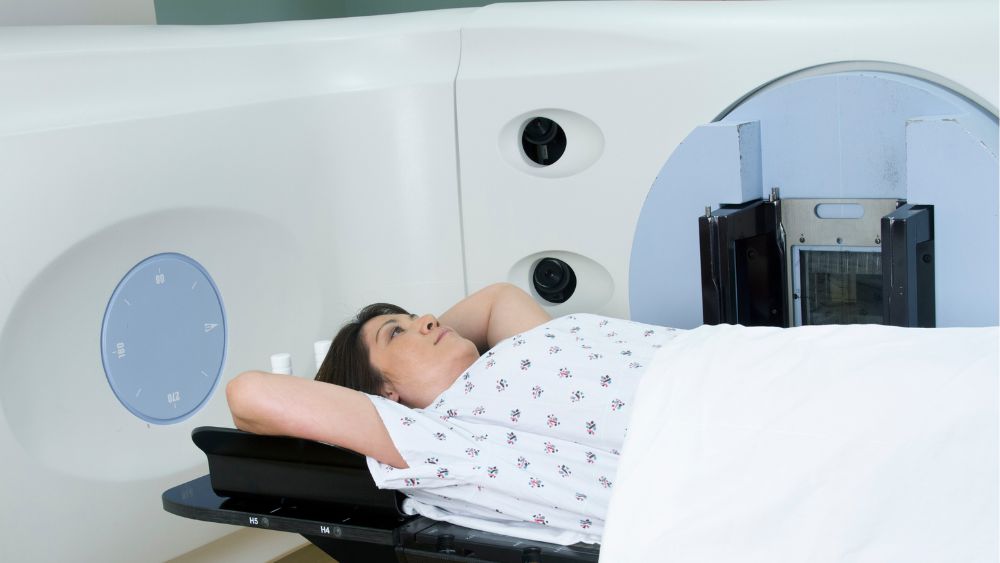Radiation therapy (radiotherapy) is a type of cancer treatment that kills or slows the growth of cancer cells by damaging their DNA. The radiation causes the cells to stop dividing or die over a period of days or weeks, continuing even after radiotherapy ends. It’s one of the most commonly used types of cancer treatment for many types of cancer, including lung cancer.
Radiation therapy for lung cancer is used in several different ways, including:
- Before surgery to shrink a tumor
- After surgery, to be sure any remaining cancer cells are killed
- To reduce pain caused by cancer that has grown in other areas of the body.
- To shrink tumors that are blocking the airway and causing breathing problems
- To treat small tumors when surgery isn’t an option.
Your lung specialist, called a pulmonologist, will work with the radiation oncologist and surgeon to create a plan that’s right for you, including the timing of each treatment. Most lung cancer treatment plans include several types of therapies.
What Types of Radiotherapy Are Used to Treat Lung Cancer?
Your oncology team considers many factors when deciding on the type of radiotherapy treatment that will best meet your needs. Factors include:
- The specific type of lung cancer
- Tumor size
- Tumor location and how close it is to normal tissue
- Your age, general health status, and medical history
- If you’ve had previous radiation for cancer treatment
Radiotherapy for lung cancer is most often delivered externally.
External Beam Radiation Therapy
The patient lies down on the linear accelerator table, and the machine delivers beams of radiation very precisely. There are a few different types of external beam radiation therapy that may be used for lung cancer. The right ones for you will be determined by your radiation oncologist.
- Intensity-modulated radiation therapy (IMRT) uses multiple radiation beams that conform to the tumor’s shape and adjusts the intensity of some of the beams to deliver radiation only to the targeted area.
- Image-guided radiation therapy (IGRT) uses 3-D images, such as CT scans, along with IMRT radiation to pinpoint and treat cancerous tumors. This is often used for types of cancer where the tumor can move slightly throughout the course of treatment. Lung tumors can move a bit because of breathing. IGRT makes it possible to be sure the radiation is delivered exactly where it needs to go during every session.
- Stereotactic body radiation therapy (SBRT) uses images from CT scans and delivers a very high radiation dose with great precision and limited damage to surrounding tissue. SBRT is commonly used to treat early-stage lung cancer when the patient cannot safely undergo surgery.
- Stereotactic radiosurgery (SRS) delivers a very high radiation dose to lung cancer tumors that have spread to the brain or spinal cord.
- Three-dimensional conformal radiation therapy (3D-CRT) uses computer software to precisely map the tumor’s location, which allows radiation beams to conform to the tumor’s shape. They can be aimed from several directions while minimizing damage to surrounding tissue.
Hypofractionated radiation therapy may be an option for lung cancer patients. It delivers a higher radiation dose in each session, making it possible for patients to complete their radiation treatments in 4-5 weeks rather than 6-8 weeks. Your radiation oncologist will determine if this is an option for you.
When Do Lung Cancer Patients Receive Radiotherapy?
Radiotherapy is used as one of several different treatments for lung cancer. The right timing depends on many things, including the type of lung cancer and its stage. The timing of delivery and goal of the treatment can vary by patient.
Killing Cancer Cells
The number one reason patients receive radiation therapy is to kill cancer cells. For early stage, non-small cell lung cancer (NSCLC), treatment frequently includes radiotherapy as an effective initial treatment.
Radiation Before Surgery to Reduce Tumor Size
Before surgery, radiotherapy can be used to help kill cancer cells and shrink tumor size, often making the surgery more successful. In some cases, after getting radiation therapy, patients who would not have been able to have surgery because the cancer was too large or close to important structures may be able to have surgery.
Radiation to Kill Remaining Cancer Cells After Surgery
After lung cancer surgery, radiotherapy effectively kills any remaining cancer cells that could not be detected or removed during surgery. This reduces the risk that cancer cells will grow after surgery.
Using Radiotherapy When Surgery Isn’t an Option
When patients are not healthy enough to undergo surgery, radiotherapy can be used.
Reducing Pain, Bleeding, Breathing Problems, or Other Symptoms with Radiation
Patients with serious symptoms such as pain, bleeding, breathing problems, or other side effects can often get relief from radiotherapy treatment.
Stopping or Limiting the Spread (Metastasis) of Cancer
Late-stage lung cancer that has spread beyond the lungs can be treated with radiotherapy to target and kill cancerous cells that have spread throughout the body to help stop or control the growth of cancer cells.
Radiotherapy can be an effective treatment in reducing the risk of lung cancer returning.
What are the Side Effects of Lung Cancer Radiotherapy?
Side effects from radiation to treat lung cancer vary for every patient; some people don’t have them. They commonly include:
- Fatigue or weakness
- Sore throat or painful swallowing
- Shortness of breath
- Skin is irritated or darkens in the area where the radiation is delivered.
- Loss of neck and chest hair
Talk to your lung cancer specialist about side effects you might expect, especially if radiation therapy is being given along with other treatments.
Getting Radiation Treatment for Lung Cancer in the Willamette Valley
Do your research about the radiation therapy center you choose, the technologies they offer, and the convenience of their clinic. It is common for lung cancer patients getting radiation therapy to have an appointment about five days a week for a 4 to 8-week time period. Make sure it’s easy to get there, park, and enter the building.
At Willamette Valley Cancer Institute (WVCI), our experienced lung cancer doctors are dedicated to providing personalized treatment for each individual. The medical oncologists and radiation oncologists work closely together, often at the same location.
Our radiation oncologists use the latest technology in radiation therapy to ensure precise and effective treatments. WVCI provides the newest and safest radiotherapy methods to patients throughout Willamette Valley. Make a treatment-planning appointment with one of our radiation oncologists at a convenient radiation cancer center in Eugene, Oregon.




